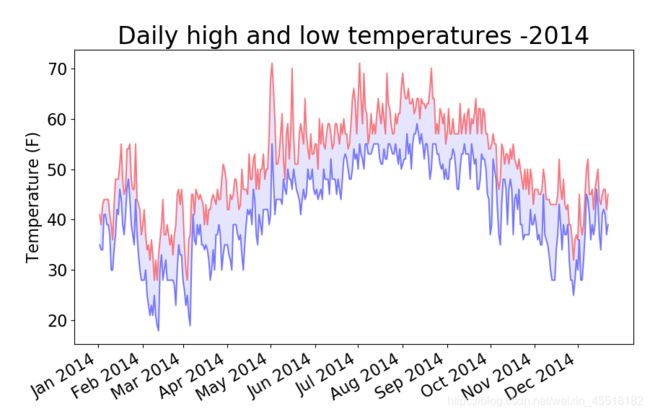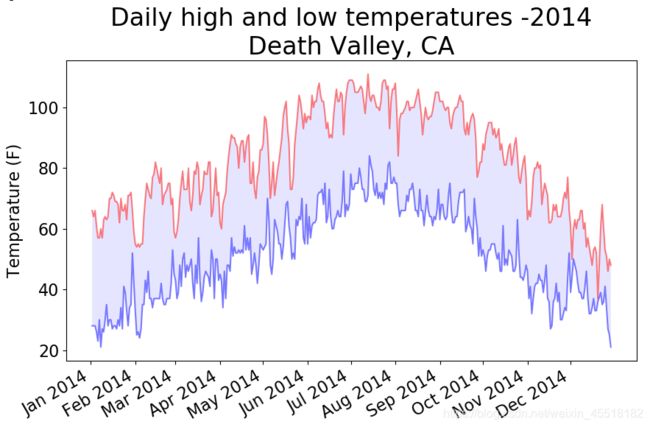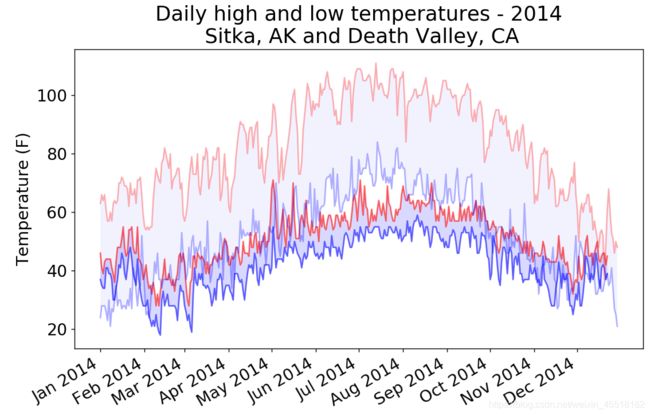天气数据图 | CSV格式 | Matplotlib | Datetime | Pandas
绘制天气图
-
- 单个地区天气图绘制
- 在一个图表中呈现两个数据集
- 降雨量绘制
单个地区天气图绘制
1、sitka_weather_2014.csv文件部分数据

'''从csv格式文件中获取锡特卡地区2014年对应日期下的最高气温、最低气温,并作图'''
import csv
from datetime import datetime
from matplotlib import pyplot as plt
from matplotlib import dates as mdate
import pandas as pd
from pandas.plotting import register_matplotlib_converters
register_matplotlib_converters()
filename='sitka_weather_2014.csv'
#打开文件
with open(filename) as f:
#读取文件所有行
reader=csv.reader(f)
#读取文件中的一行
header_row=next(reader)
#从文件中获取日期,最高气温,最低气温
dates,highs,lows=[],[],[]
for row in reader:
#读取每行数据的第1列
current_date=datetime.strptime(row[0],"%Y-%m-%d")
dates.append(current_date)
#读取每行数据的第2列
high=int(row[1])
highs.append(high)
#读取每行数据的第4列
low=int(row[3])
lows.append(low)
#根据数据绘制图表
fig=plt.figure(figsize=(10,6))
plt.plot(dates,highs, c='red',alpha=0.5)
plt.plot(dates,lows,c='blue',alpha=0.5)
#为绘图区域填充颜色,为蓝色
plt.fill_between(dates,highs,lows,facecolor='blue',alpha=0.1) #alpha设置颜色透明度,默认为1,表示完全不透明
plt.title("Daily high and low temperatures -2014", fontsize=24)
#在原图像位置设置一个新的图像
ax=fig.add_subplot(1,1,1)
#设置x轴的格式为[%b:月份的缩写][%Y:年份]
ax.xaxis.set_major_formatter(mdate.DateFormatter('%b %Y'))
#设置x轴范围
plt.xticks(pd.date_range('2014-01','2014-12',freq='MS'),rotation=30) #freq='MS':设置刻度格式为每月的开始(month start frequency)
plt.xlabel(' ',fontsize=16)
fig.autofmt_xdate() #绘制斜的日期标签,避免彼此重叠
plt.ylabel('Temperature (F)',fontsize=16)
plt.tick_params(axis='both',which='major',labelsize=16)
plt.show()
作图如下:

x轴标签设置参考:
https://www.jianshu.com/p/2a96f0cafbf1
添加错误检查代码,解决因数据缺失引发的异常
2、death_valley_2014.csv文件部分数据

import csv
from datetime import datetime
from matplotlib import pyplot as plt
from matplotlib import dates as mdate
import pandas as pd
from pandas.plotting import register_matplotlib_converters
register_matplotlib_converters()
#从文件中获取日期和最高气温
filename='death_valley_2014.csv'
#打开文件
with open(filename) as f:
#读取文件所有行
reader=csv.reader(f)
#读取文件中的一行
header_row=next(reader)
header_row=next(reader)
#从文件中获取日期,最高气温,最低气温
dates,highs,lows=[],[],[]
for row in reader:
try:
#读取每行数据的第1列
current_date=datetime.strptime(row[0],"%Y-%m-%d")
#读取每行数据的第2列
high=int(row[1])
#读取每行数据的第4列
low=int(row[3])
except ValueError:
#打印一条错误消息,指出缺失数据的信息
print(current_date,'missing data')
else:
dates.append(current_date)
highs.append(high)
lows.append(low)
#根据数据绘制图表
fig=plt.figure(figsize=(10,6))
plt.plot(dates,highs, c='red',alpha=0.5)
plt.plot(dates,lows,c='blue',alpha=0.5)
#为绘图区域填充颜色,为蓝色
plt.fill_between(dates,highs,lows,facecolor='blue',alpha=0.1) #alpha设置颜色透明度,默认为1,表示完全不透明
plt.title("Daily high and low temperatures -2014\nDeath Valley, CA", fontsize=24)
#在原图像位置设置一个新的图像
ax=fig.add_subplot(1,1,1)
#设置x轴的格式为[%b:月份的缩写][%Y:年份]
ax.xaxis.set_major_formatter(mdate.DateFormatter('%b %Y'))
#设置x轴范围
plt.xticks(pd.date_range('2014-01','2014-12',freq='MS'),rotation=30) #freq='MS':设置刻度格式为每月的开始(month start frequency)
plt.xlabel(' ',fontsize=16)
fig.autofmt_xdate() #绘制斜的日期标签,避免彼此重叠
plt.ylabel('Temperature (F)',fontsize=16)
plt.tick_params(axis='both',which='major',labelsize=16)
plt.show()
在一个图表中呈现两个数据集
import csv
from datetime import datetime
from matplotlib import pyplot as plt
from matplotlib import dates as mdate
import pandas as pd
from pandas.plotting import register_matplotlib_converters
register_matplotlib_converters()
def get_weather_data(filename,dates,highs,lows):
'''Get the highs and lows from a data file.'''
with open(filename) as f:
#读取文件所有行
reader=csv.reader(f)
#读取文件中的一行
header_row=next(reader)
for row in reader:
try:
#读取每行数据的第1列
current_date=datetime.strptime(row[0],"%Y-%m-%d")
#读取每行数据的第2列
high=int(row[1])
#读取每行数据的第4列
low=int(row[3])
except ValueError:
print(current_date,'missing data')
else:
dates.append(current_date)
highs.append(high)
lows.append(low)
#绘制锡特卡地区图表
dates,highs,lows=[],[],[]
get_weather_data('sitka_weather_2014.csv',dates,highs,lows)
fig=plt.figure(dpi=128,figsize=(10,6))
plt.plot(dates,highs, c='red',alpha=0.6)
plt.plot(dates,lows,c='blue',alpha=0.6)
#为绘图区域填充颜色,为蓝色
plt.fill_between(dates,highs,lows,facecolor='blue',alpha=0.15) #alpha设置颜色透明度,默认为1,表示完全不透明
#绘制死亡谷地区图表
dates,highs,lows=[],[],[]
get_weather_data('death_valley_2014.csv',dates,highs,lows)
plt.plot(dates,highs, c='red',alpha=0.3)
plt.plot(dates,lows,c='blue',alpha=0.3)
#为绘图区域填充颜色,为蓝色
plt.fill_between(dates,highs,lows,facecolor='blue',alpha=0.05) #alpha设置颜色透明度,默认为1,表示完全不透明
#format plot
title = "Daily high and low temperatures - 2014"
title += "\n Sitka, AK and Death Valley, CA"
plt.title(title, fontsize=20)
#在原图像位置设置一个新的图像
ax=fig.add_subplot(1,1,1)
#设置x轴的格式为[%b:月份的缩写][%Y:年份]
ax.xaxis.set_major_formatter(mdate.DateFormatter('%b %Y'))
#设置x轴范围
plt.xticks(pd.date_range('2014-01','2014-12',freq='MS'),rotation=30) #freq='MS':设置刻度格式为每月的开始(month start frequency)
plt.xlabel(' ',fontsize=16)
fig.autofmt_xdate() #绘制斜的日期标签,避免彼此重叠
plt.ylabel('Temperature (F)',fontsize=16)
#plt.ylim(ymin=0,ymax=120)
plt.tick_params(axis='both',which='major',labelsize=16)
plt.show()
降雨量绘制
数据来源:https://github.com/ehmatthes/pcc/blob/gh-pages/resources/sitka_rainfall_2015.csv
import csv
from datetime import datetime
from matplotlib import pyplot as plt
from matplotlib import dates as mdate
import pandas as pd
from pandas.plotting import register_matplotlib_converters
register_matplotlib_converters()
# Get dates and rainfall data from data file
# raindata is in column 19
filename = 'sitka_rainfall_2015.csv'
with open(filename) as f:
reader=csv.reader(f)
header_row=next(reader)
dates, rainfalls=[],[]
for row in reader:
try:
current_date=datetime.strptime(row[0],"%Y/%m/%d")
rainfall=float(row[19])
except ValueError:
print(current_date,'missing data')
else:
dates.append(current_date)
rainfalls.append(rainfall)
#Plot data.
fig=plt.figure(dpi=128,figsize=(10,6))
plt.plot(dates,rainfalls,c='blue',alpha=0.5)
plt.fill_between(dates,rainfalls,facecolor='blue',alpha=0.2)
#Format plot
title="Daily rainfall amounts - 2015\nSitka, AK"
plt.title(title,fontsize=20)
ax=fig.add_subplot(1,1,1)
ax.xaxis.set_major_formatter(mdate.DateFormatter('%b %Y'))
plt.xticks(pd.date_range('2015-01','2015-12',freq='MS'),rotation=30) #freq='MS':设置刻度格式为每月的开始(month start frequency)
plt.xlabel('',fontsize=16)
fig.autofmt_xdate()
plt.ylabel("Rainfall (in)", fontsize=16)
plt.tick_params(axis='both',which='major',labelsize=16)
plt.show()


